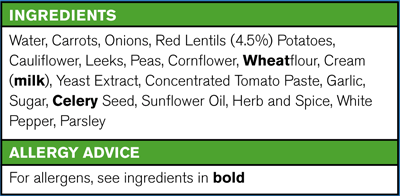Section 3: Other information on product packaging
Mandatory nutrition labelling
It will be mandatory for food and drink manufacturers to provide nutrition
information on almost all food and drink [1]; you'll usually find this on the back of product packaging.
Nutrients will have to be listed in a certain order – energy (both in kilojoules
and kilocalories) and the amounts of fat, saturates, carbohydrates, sugars,
protein and salt (in place of 'sodium' which is no longer permitted).
The information has to be given per 100g/ml but can additionally be given:
- Per portion or per consumption unit (e.g. per slice)
- As % Reference Intakes (formerly known as Guideline Daily Amounts)
Information on the following nutrients can be provided in a voluntary basis:
mono and poly-unsaturates, polyols, starch and fibre. Information on certain
vitamins and minerals can be given if listed on an approved list and present in
significant amounts.[2]
IMPORTANT: If a nutrition claim is made then it becomes mandatory to give information
about that nutrient, even if it is not listed in the regulation. For example if
the
claim 'high in omega 3' was made then the amount of omega 3 per 100g would have
to be given.
Notes
1. Exemptions from mandatory labelling are listed in Annex V of the Regulation
2. Approved vitamins and minerals are listed in Annex XIII of the Regulation
top
Ingredients list
All of the ingredients of a product are listed in descending order of weight in
an ingredients list. The amount of the ingredients used in a product will also
be stated where:
- The ingredient (e.g. steak and kidney pie) or category of ingredients (e.g.
vegetable pasty) appears in the name of the food.
- It is usually associated with that name by the consumer e.g. lamb in a
shepherd's pie.
- It is emphasised on the labelling in words, pictures or graphics e.g.
strawberry
in a yogurt described as having 'chunks of real strawberry'.
- The ingredient is essential to characterise a food.
The ingredients list can also help if someone wants to look for, or avoid, a
certain ingredient. For example:
- Vegetable oils and fats can be grouped together in the ingredients list under
the term 'vegetable oils' or 'vegetable fats' but this must be followed by the
type of vegetable origin (e.g. palm, sunflower or rapeseed) and the phrase 'in
varying proportions'.
- If 'hydrogenated oil' is included in the product, it must be described as either
'fully hydrogenated' or 'partially hydrogenated'. It is partially hydrogenated
oil that contains artificial trans fatty acids not fully hydrogenated oil.
IMPORTANT: If it's not listed on the ingredients list, it's not in the product.
top
Allergen information
Fourteen major food allergens must be emphasised in the ingredients list.
These are: cereals containing gluten, crustaceans (e.g. prawns or crab),
molluscs (e.g. clams or mussels), eggs, fish, peanuts, nuts, soybeans, milk,
celery,
mustard, sesame, lupin and sulphur dioxide.
Where the allergen is not obvious from the name of the ingredient, there will
be a clear reference to the name of the allergen next to the ingredient e.g.
'casein' (milk) or 'tofu' (soya).
Food businesses can choose the method of emphasis that they would like to use,
for example, bold, italics, highlighting, contrasting colours, CAPITALISING
TEXT
and underlining.
An allergy advice statement may also be used to direct consumers to the
ingredients list for allergen information.

- Use of statements such as 'Contains: milk, nuts' to summarise allergen
ingredient information will no longer be allowed.
The only exception to this is for products that do not have an ingredients
list, such as wine where a 'contains: sulphites' may be used.
- No more references to gluten.
Consumers will instead need to look for the cereals containing gluten, such
as
wheat, rye and barley, which will be emphasised in the ingredients list.
IMPORTANT: Always check the ingredients list for allergen information.
top